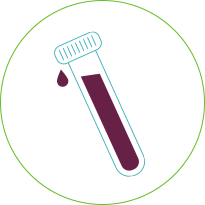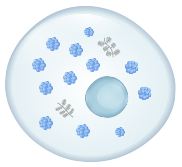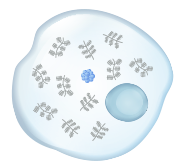
What is Morquio A?
Morquio A is a rare and progressive inherited disease. It affects everyone differently, impacting organs, bones, and other parts of the body. Morquio A is a form of mucopolysaccharidosis (MPS), a lysosomal storage disorder.
What happens in Morquio A?
- People with Morquio A do not make enough of a specific enzyme (en·zyme) in their cells, called N-acetylgalactosamine-6 sulfatase, or GALNS (gal·en·es)
- GALNS breaks down and recycles GAGs (gags), cellular waste that builds up inside cells. In Morquio A, the particular GAG is called keratan sulfate (KS)
- GAGs collect in organs, bones, and other parts of the body
Cause & Genetics
Morquio A is caused by mutations in the GALNS gene. These mutations are why people with Morquio A do not make enough GALNS.
Morquio A is an autosomal (au·to·so·mel) recessive disease, which means both parents must have the same genetic mutation to pass on Morquio A.
- Parents can either have Morquio A or be carriers of the mutation. Carriers are people who are healthy, but can still pass on their gene mutation
- Both boys and girls can inherit Morquio A
If 2 parents who are carriers of Morquio A have a child, there is a:
- 25% chance the child will inherit Morquio A
- 50% chance the child is a carrier of the gene mutation (just like the parents)
- 25% chance the child is healthy (neither inheriting Morquio A nor a carrier)
MORQUIO A IS A HETEROGENEOUS DISEASE
Morquio A is heterogeneous (het·er·o·ge·ne·ous), which means that for each person with Morquio A:
- Signs and symptoms are different
- Severity of signs and symptoms may vary
There are over 270 mutations of the GALNS gene, which may be why people with Morquio A experience varying symptoms and disease severity.

Signs & Symptoms
When do signs and symptoms start?
The signs and symptoms of Morquio A affect individuals differently. For many, enough GAGs have built up by age 2 or 3 to start causing problems such as oddly shaped bones, knock knees, a curved spine, and irregular chest growth. For some people, more serious symptoms can begin at 6 months old, while others may not see initial symptoms (hip stiffness and pain) until the second decade of life. Regardless of when these various symptoms begin, Morquio A is a progressive disease that can change over time.
SIGNS & SYMPTOMS OVERVIEW
In Morquio A, it is common for people to have complications in their:
- Bones and spine
- Lungs and airways
- Heart
- Eyes and ears
- Teeth
- Digestive tract
While Morquio A symptoms can vary, many patients may share yours. Read the stories of others with Morquio A by joining MorCommunity.
Tests & Diagnosis
Enzyme Activity: The “Gold Standard” for Diagnosis
Enzyme activity testing is considered the “gold standard” for diagnosing Morquio A. Usually done by analyzing a person’s blood, the enzyme test measures the activity of GALNS in the body.
OTHER TESTS FOR MORQUIO A
When getting tested for Morquio A, your doctor may also perform:

Urine test. This test measures the GAG level in a person’s urine
Molecular testing. This is an optional test that identifies mutations in the GALNS gene. Molecular testing is necessary for prenatal and genetic carrier testing. This can reduce the risk of passing the disease on in families.
Role of the geneticist and other specialists in diagnosis
People with Morquio A need a coordinated healthcare team that includes a geneticist and a variety of doctors called specialists.
Diagnosis of Morquio A requires a visit to a geneticist, a doctor who treats patients with genetic disorders.
- Need help finding a clinic near your home? Find a clinic
- Have other questions about diagnosis? Contact BioMarin




